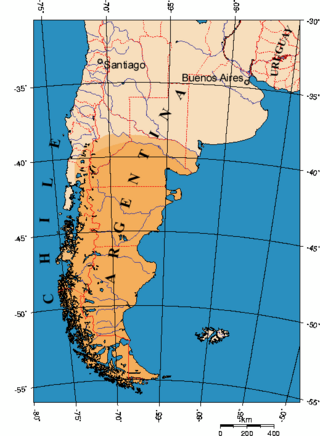
Patagonia refers to a geographical region that encompasses the southern end of South America, governed by Argentina and Chile. The region comprises the southern section of the Andes Mountains with lakes, fjords, temperate rainforests, and glaciers in the west and deserts, tablelands and steppes to the east. Patagonia is bounded by the Pacific Ocean on the west, the Atlantic Ocean to the east, and many bodies of water that connect them, such as the Strait of Magellan, the Beagle Channel, and the Drake Passage to the south.

Charles IV 11 November 1748 – 20 January 1819) was King of Spain and ruler of the Spanish Empire from 1788 to 1808.
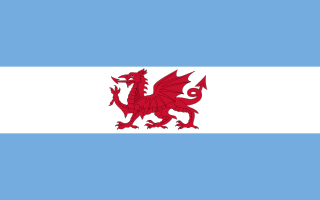
Y Wladfa, also occasionally Y Wladychfa Gymreig, refers to the establishment of settlements by Welsh immigrants in Patagonia, beginning in 1865, mainly along the coast of the lower Chubut Valley. In 1881, the area became part of the Chubut National Territory of Argentina which, in 1955, became Chubut Province.
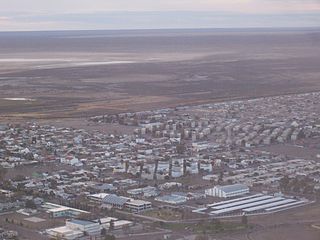
Rawson (Spanish pronunciation: [ˈrawson] is the capital of the Argentine province of Chubut, in Patagonia. It has 24,616 inhabitants in 2010, and it is the chief town of the Rawson Department.
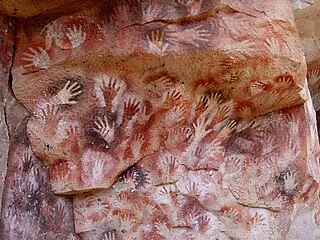
Cueva de las Manos is a cave and complex of rock art sites in the province of Santa Cruz, Argentina, 163 km (101 mi) south of the town of Perito Moreno. It is named for the hundreds of paintings of hands stenciled, in multiple collages, on the rock walls. The art was created in several waves between 7,300 BC and 700 AD, during the Archaic period of pre-Columbian South America. The age of the paintings was calculated from the remains of bone pipes used for spraying the paint on the wall of the cave to create the artwork, radiocarbon dating of the artwork, and stratigraphic dating.

Puerto San Julián, also known historically as Port St. Julian, is a natural harbour in Patagonia in the Santa Cruz Province of Argentina located at 49°18′S67°43′W. In the days of sailing ships it formed a stopping point, 180 km (112 mi) south of Puerto Deseado. Nowadays Puerto San Julián is also the name of a small town located on the harbour.
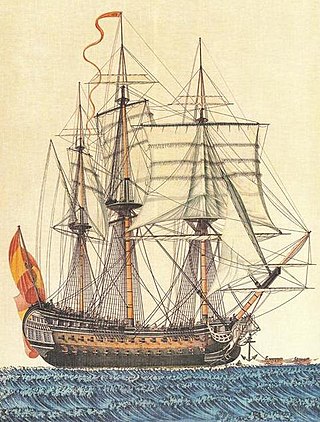
San Telmo was a Spanish 74-gun ship of the line, launched in 1788. It sank while bringing reinforcements to Peru during the war of independence, and some of its crew or passengers may have discovered and landed on Antarctica.
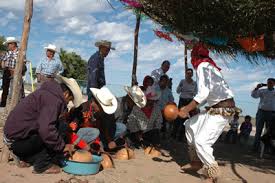
The Mayo or Yoreme are an indigenous group in Mexico, living in the northern states of southern Sonora, northern Sinaloa and small settlements in Durango.

Maria Luisa of Parma was, by marriage to King Charles IV of Spain, Queen of Spain from 1788 to 1808 leading up to the Peninsular War. Her relationship with Manuel Godoy and influence over the King made her unpopular among the people and aristocrats. She was rivals with the Duchess of Alba and the Duchess of Osuna, attracting popular attention. The death of her daughter-in-law Princess Maria Antonia of Naples and Sicily, whom she disliked, was said to be the poisoning by the Queen.

Patagonian Welsh is a variety of the Welsh language spoken in Y Wladfa, the Welsh settlement in Patagonia, Chubut Province, Argentina. The decimal numeral system used in Modern Welsh originated in Patagonia in the 1870s, and was subsequently adopted in Wales in the 1940s as a simpler counterpart to the traditional vigesimal system, which still survives in Wales.

The Chiloé Archipelago is a group of islands lying off the coast of Chile, in the Los Lagos Region. It is separated from mainland Chile by the Chacao Channel in the north, the Sea of Chiloé in the east and the Gulf of Corcovado in the southeast. All islands except the Desertores Islands form Chiloé Province. The main island is Chiloé Island. Of roughly rectangular shape, the southwestern half of this island is a wilderness of contiguous forests, wetlands and, in some places, mountains. The landscape of the northeastern sectors of Chiloé Island and the islands to the east is dominated by rolling hills, with a mosaic of pastures, forests and cultivated fields.

Nombre de Jesús was a Spanish town in Patagonia, settled in 1584 by Pedro Sarmiento de Gamboa in the Magellan Strait. Nombre de Jesús also refers to the archaeological site located in Santa Cruz Province, Argentina, where the remains of this settlement were found. This was the first European settlement in the Magellan Strait.
Swiss Argentines are Argentine citizens of Swiss ancestry or people who emigrated from Switzerland and reside in Argentina. The Swiss Argentine community is the largest group of the Swiss diaspora in South America.

León Ortiz de Rozas was a Spanish military and politician, who had an active participation during the colonial and post colonial period of Argentina. He served as Commander in the military expeditions against the Indians during the Viceroyalty of the Río de la Plata.

Mennonites in Argentina belong to two quite different groups: conservative and very conservative Plautdietsch-speaking group of Russian Mennonites who are descendants of Friesian, Flemish and Prussian people, and converts to the Mennonite faith from the general Argentinian population. The Russian Mennonites are the third largest community of Mennonites in South America, with six colonies in Argentina. While Russian Mennonites have their own language and customs and live in colonies, converts to the Mennonite faith normally live in cities and speak Spanish and do not differ much from other Protestants in Argentina. Conservative ethnic Mennonites normally do not engage in missionary activities but look for a quiet and remote place where they can live according to their tradition. More liberal Mennonites are engaged in worldwide missionary work like other North American Protestant denominations. About one third of Mennonites in Argentina are conservative ethnic Mennonites who belong to the Altkolonier branch.
In Colonial times the Spanish Empire diverted significant resources to fortify the Chilean coast as consequence of Dutch and English raids. The Spanish attempts to block the entrance of foreign ships to the eastern Pacific proved fruitless due to the failure to settle the Strait of Magellan and the discovery of the Drake Passage. As result of this the Spanish settlement at Chiloé Archipelago became a centre from where the west coast of Patagonia was protected from foreign powers. In face of the international wars that involved the Spanish Empire in the second half of the 18th century the Crown was unable to directly protect peripheral colonies like Chile leading to local government and militias assuming the increased responsibilities.
In Colonial times the Spanish Empire diverted significant resources to fortify the Chilean coast as a consequence of Dutch and English raids. During the 16th century the Spanish strategy was to complement the fortification work in its Caribbean ports with forts in the Strait of Magellan. As attempts at settling and fortifying the Strait of Magellan were abandoned the Spanish began to fortify the Captaincy General of Chile and other parts of the west coast of the Americas. The coastal fortifications and defense system was at its peak in the mid-18th century.

Carlos Joaquín Gradin, also known as Carlos Gradín, was an Argentine surveyor and archaeologist. He carried out numerous studies in the Patagonian region, and is known for his extensive studies of Cueva de las Manos. He was a member of the National Scientific and Technical Research Council (CONICET).
Los Toldos is an archaeological site in Santa Cruz, Argentina, which has evidenced human activity dating back almost 13,000 years ago. It is the namesake of the Toldense culture group.
Chilean colonization of the Strait of Magellan began in 1843 when an expedition founded Fuerte Bulnes. In 1848 the settlement of Punta Arenas was established further north in the strait and grew eventually to become the main settlement in the strait, a position it holds to this day. The Chilean settlement of the strait was crucial to establish its sovereignty claims in the area. Argentina formally recognised Chilean sovereignty in 1881. The Magallanes territory was made a regular Chilean province in 1928.
















